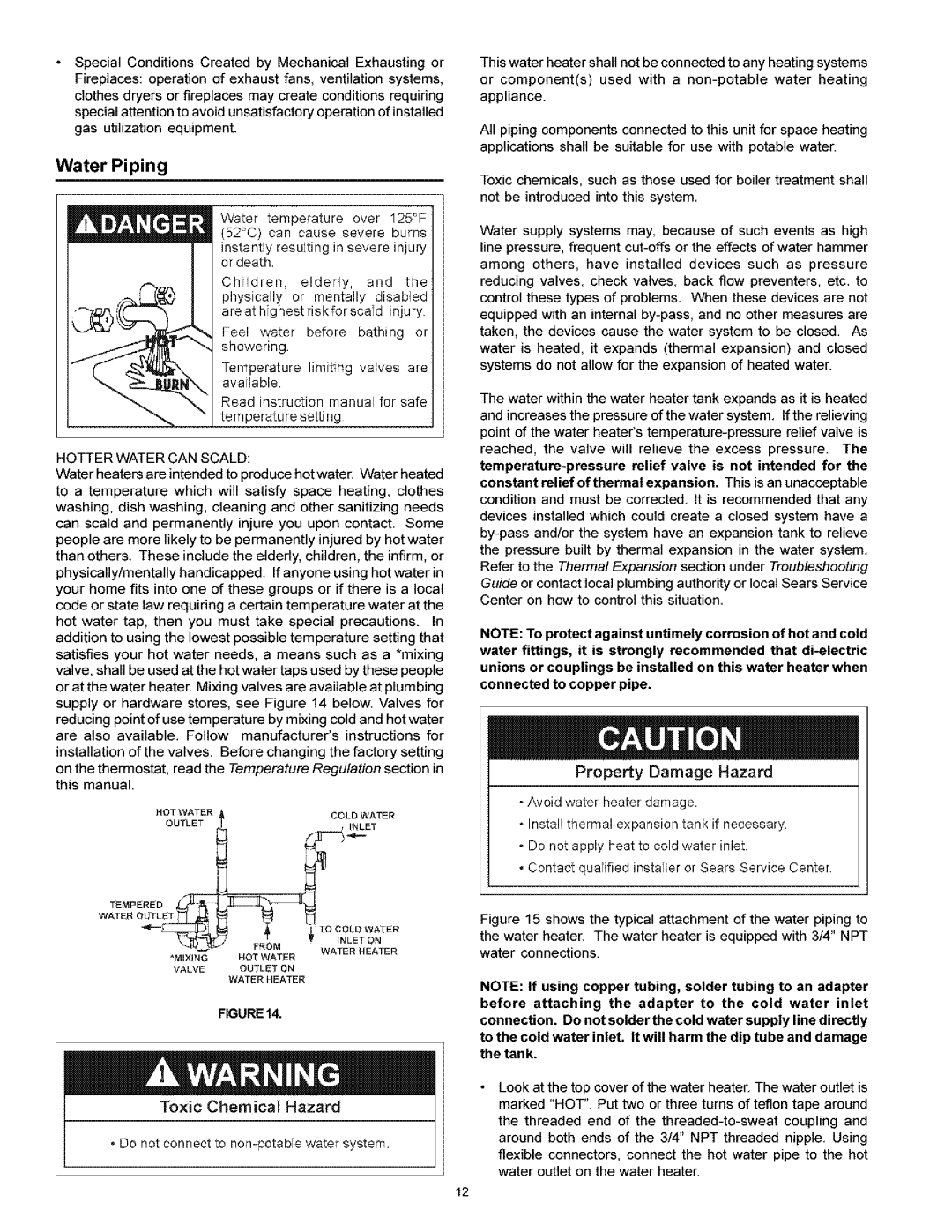
•Special Conditions Created by Mechanical Exhausting or Fireplaces: operation of exhaust fans, ventilation systems, clothes dryers or fireplaces may create conditions requiring special attention to avoid unsatisfactory operation of installed gas utilization equipment.
Water Piping
Water temperature over 125°F (52°C) car cause severe burns instantly resulting in severe injury or death.
Children, elderly, and the physically or mentally disabled are at h ghest risk_or scald injury
Feel water before bathing or showering.
Temperature limitr_g valves are available.
Read instruction manuaJ for safe temperature setting
HOTTER WATER CAN SCALD:
Water heaters are intended to produce hot water. Water heated to a temperature which will satisfy space heating, clothes washing, dish washing, cleaning and other sanitizing needs can scald and permanently injure you upon contact. Some people are more likely to be permanently injured by hot water than others. These include the elderly, children, the infirm, or physically/mentally handicapped. If anyone using hot water in your home fits into one of these groups or if there is a local code or state law requiring a certain temperature water at the
hot water tap, then you must take special precautions. In addition to using the lowest possible temperature setting that satisfies your hot water needs, a means such as a *mixing valve, shall be used at the hot water taps used by these people or at the water heater. Mixing valves are available at plumbing supply or hardware stores, see Figure 14 below. Valves for reducing point of use temperature by mixing cold and hot water are also available. Follow manufacturer's instructions for installation of the valves. Before changing the factory setting
on the thermostat, read the Temperature Regulation section in this manual.
HOT WATER | COLD WATER | |
OUTLET | ||
, INLET | ||
|
|
| ,OCeLOWATE |
|
| INLET ON |
| FROM | WATER HEATER |
*MIXiN | HOT WATER | |
VALVE | OUTLET | ON |
WATER HEATER
FIGURE14.
Toxic Chemical Hazard
•Do not connect to
This water heater shall not be connected to any heating systems
or component(s) used with a
All piping components connected to this unit for space heating applications shall be suitable for use with potable water.
Toxic chemicals, such as those used for boiler treatment shall not be introduced into this system.
Water supply systems may, because of such events as high line pressure, frequent
The water within the water heater tank expands as it is heated and increases the pressure of the water system. If the relieving point of the water heater's
NOTE: To protect against untimely corrosion of hot and cold water fittings, it is strongly recommended that
Property Damage Hazard
•Avoid water heater damage.
•Install thermal expansion tank if necessary.
•Do not apply heat to cold water inlet.
•Contact qualified insta/ier or Sears Service Center
Figure 15 shows the typical attachment of the water piping to the water heater. The water heater is equipped with 3/4" NPT water connections.
NOTE: if using copper tubing, solder tubing to an adapter before attaching the adapter to the cold water inlet connection. Do not solder the cold water supply line directly to the cold water inlet. It will harm the dip tube and damage the tank.
•Look at the top cover of the water heater. The water outlet is marked "HOT". Put two or three turns of teflon tape around the threaded end of the threaded-to-sweat coupling and around both ends of the 3/4" NPT threaded nipple. Using flexible connectors, connect the hot water pipe to the hot water outlet on the water heater.
12
